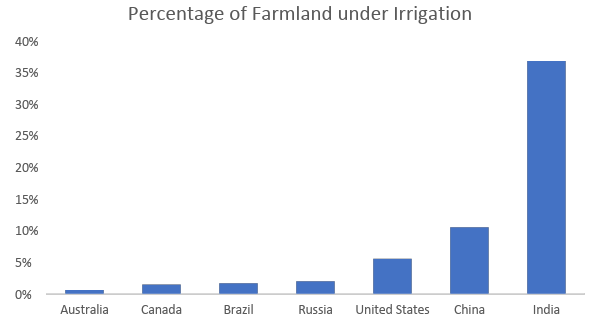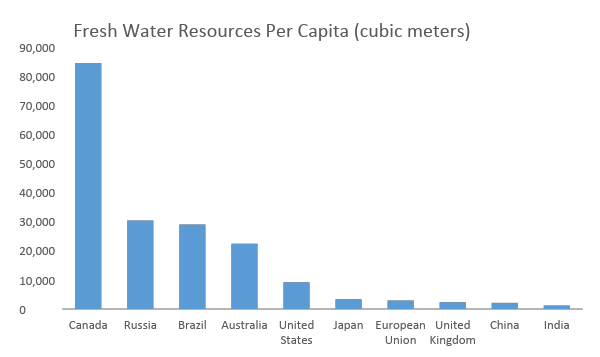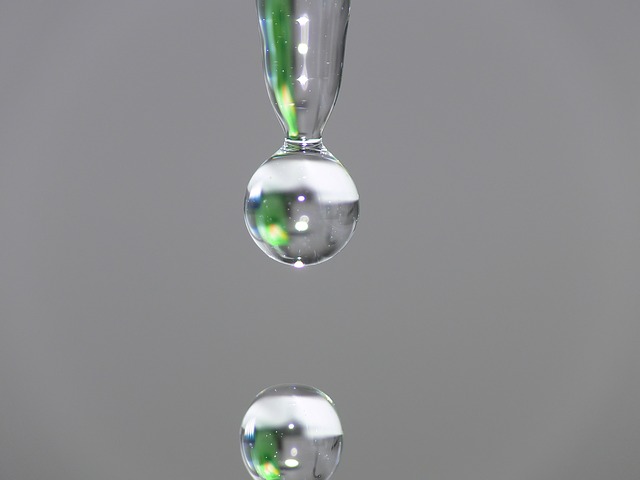June 10, 2019
This is the third article in an eight-part series published by GAI News that examines eight existing trends set to alter the structure of our global food system. Join us each month for a new installment, and be sure to read the first two articles here: Part I, Part II.
-By Jeremy Stroud, Bonnefield Agricultural Investment Analyst, and Michael DeSa of AGD Consulting
“In all affairs it’s a healthy thing now and then to hang a question mark on the things you have long taken for granted.” – Bertrand Russell
There is every reason for us as consumers to pause and consider something that is far too often taken for granted – water. It has become a truism to say that civilization would not exist without the reliability of our earth’s accessible water resources. Our species’ ability to evolve past a Paleolithic state is a direct result of our advances in freshwater use, from leveraging gravity for flood irrigation, to controlling water flow with aqueducts, to the implementation of digitally-integrated irrigation systems.
![]() Societal reliance on fresh water has been presupposed for so many centuries that many of us overlook the ongoing constraints set to fundamentally alter the way we use this scarce resource. This article aims to review a few of the many water challenges affecting the global agri-food sector and places a spotlight on investable regions which may weather the storm most effectively.
Societal reliance on fresh water has been presupposed for so many centuries that many of us overlook the ongoing constraints set to fundamentally alter the way we use this scarce resource. This article aims to review a few of the many water challenges affecting the global agri-food sector and places a spotlight on investable regions which may weather the storm most effectively.
When assessing freshwater availability, it is essential to consider the components of the water system within and beyond human control. The thought of addressing all water challenges may be an overwhelmingly broad topic, so the conversation becomes more actionable when we focus on components that can be changed rather than those that cannot. Of freshwater stores, ‘blue water’ is the most pertinent topic to international agriculture as we have little control over deviation in rainwater occurrence and quantity. Water scientists place particular emphasis on blue water within the context of a changing climate – namely as it pertains to projected increases in the frequency and severity of global drought.(1)
Common Freshwater Classification(2)

Less than 3 percent of the earth’s total water stock is fresh water and nearly four-fifths of the 3 percent are permanently frozen and inaccessible. (3) In other words, this equates to about 10,000,000 cubic km of fresh, accessible ground and surface water. (4) After factoring in areas of excessive pollution, acidity, and salinization we are left with less than one-tenth of a percent of fresh water supply available for human, agriculture, and industry use. (5) While freshwater is limited in volume, humans are continuing to increase consumption per capita on an annual basis (6), and at a pace that far exceeds the rate of replenishment. (7) Here lies the bone of contention. It is not a question of whether we are using scarce water resources at an unsustainable pace, but rather a discussion of what can be done about it.
Blue Water – Consumable and Irrigatable
Water use for irrigation is among the most heavily contested aspects of the modern agricultural system. Agriculture and blue water depletion are inextricably linked. According to a recent report from Intergovernmental Science-Policy Platform on Biodiversity and Ecosystem Services (IPBES), nearly 75 percent of the world’s accessible freshwater consumption is dedicated to crop and livestock production and nearly 40 percent of the planet’s current food supply is reliant on irrigation.(8) This issue becomes further pronounced when we consider that nearly half of the world’s population is living within immediate proximity to river basins and aquifers with the ‘severe water stress’ classification.(9) Evidence suggests that over usage and maltreatment of accessible freshwater resources could cause a contraction in global productivity growth, and therefore a potential decline in living standards.(10)
Most of our planet’s accessible fresh water is confined in shallow aquifers beneath the earth’s surface. A high proportion of these non-renewable aquifers are reaching critical points of depletion, and they are commonly located in areas which fall beneath the world’s most populous and important agricultural regions. A study from the Proceedings of the National Academy of Science estimates that up to 100 million irrigated acres may be unable to draw sufficient water resources to support production by the end of the century.(11) This could lead to drastic decreases in crop yields if rainfall averages cannot make up the difference. The Ogallala aquifer beneath the U.S. Corn Belt, for example, is particularly threatened by overuse and pollutant contamination. A reversal of irrigated land to dryland is expected to occur in regions such as California’s central valleys, the U.S. Midwest, the North-China Plain, and the Arabian Basin. In each of these regions, non-renewable groundwater is a primary source of irrigation. It is not coincidental that each of these regions have been subject to significant water stress in the past decade.
Blue water depletion is a complex issue that demands collective action – not solvable by implementing any single policy, action, or framework, but rather it requires a cooperation between all levels of business, government, and society. Irrigated farms that source their water from continually measured, renewable deposits (such as sustainably disbursed lakes and river systems) may be the most productive, economical, and sustainable solution to the forthcoming water scarcity challenges.
Virtual Water
Consumers may look at food-induced water depletion as a direct product of farm activity, while the reality is more complex and integrates all facets of society. Farmers, like any other business, are economic entities that aim to optimize output, scale, and profitability. In the agri-food sector this is accomplished by efficiently fulfilling the needs of consumers. With a growing population and an increasing appetite for high-quality proteins, fruits, and vegetables, consumers tend not to realize the macro-effects of their individual purchasing decisions, but rather focus on the needs of the household or community.
As it stands, we have a developed consumer base that is unaware that we effectively outsource water depletion through our demand for high water-footprint foods.(12) An often cited example is China’s import of water-intensive soybeans from areas such as Brazil, which has led to indirect pressure on deforestation of the Amazon.(13) We have historically been able to purchase food and industrial products with the cost of water extraction embedded in the price, but often not the true cost of water depletion. This distinction is vital to the topic of global water management, where governments often subsidize industry water use as a regular cost of doing business in order to provide consumers with food options that meet their demands.
Most experts believe these consumer trends towards high-footprint foods are firmly established, although as shoppers begin to realize the increased demands on water is a result of their decisions, they too may begin to search for more sustainable and renewable ways to use the available water supply. It is here where we see a long-term investable opportunity.
Farmland Investing: Go Where the Renewable Water Flows
The pursuit of a sustainable and profitable agricultural investment portfolio may be achieved through consideration of macro-climatic indicators, strategic selection, and rigorous due diligence. While this article refers to agricultural investing from a farmland perspective, there also is a case to be made for investments in agricultural technology, including efficient irrigation, wastewater reuse, soil moisture sensing, and seed resilience technologies.
A structural decline in crop production is expected to create supply shocks in the future, potentially raising agricultural commodity prices in the long term. The Intergovernmental Panel on Climate Change (IPCC) estimates that crop yields could decline by up to 12 percent as a consequence of water scarcity in the next three decades.(14) The thesis of investing in ‘water-rich’ regions is predicated upon their capacity to weather an incoming storm of potential water issues:
~ Invest where irrigation is less necessary for productive agriculture: Less than 4 percent of Canada, Brazil, Russia, and Australia’s farmland is irrigated compared to about 10 percent in the United States and 37 percent in India (15)(See Figure 2). Productive agricultural regions that are less dependent on irrigation tend to hedge the risk of groundwater depletion and/or pollution.
Figure 2: Percentage of Farmland Under Irrigation(16)

Source: The World Bank World Development Indicators, 2015
~ Analyze metrics to determine where water shortages are expected to fall: Statistics such as renewable fresh water per capita are helpful in determining where water crises are expected to occur. Other helpful statistics include aquifer replenishment rates, variable on-farm water requirements, and the legal parameters of water resource allocation. While Canada, Russia, Australia, and Brazil use relatively little water for irrigation compared to the rest of the world, they hold the most fresh water reserves per capita of all agricultural exporters with 80,200 cubic meters.(17) Further projections suggest that warm-climate regions are likely to experience decreasing precipitation levels in the next century while polar and continental regions may encounter more rainfall.(18) Although each country’s water rights laws and natural precipitation levels may vary, the thesis holds over a long-term geographic perspective while political frameworks may change. This sentiment should be further examined at a regional level to assess where irrigating farmland may be achieved most sustainably.
Figure 4: Global Freshwater Resources per Capita(19)

Source: The World Bank, 2014
For as long as humans inhabit the planet, unpolluted, fresh, water will be a finite resource with limited supply and consistent demand. Although specific water reserves appear to have promise over the next several decades, it is a responsibility for farm owners, governments, consumers, and investors to responsibly regulate withdrawal and avert contamination. Freshwater depletion is an agricultural issue just as much as it is an environmental one. Here lies a rare circumstance where economic returns may be matched by environmental impact. Agricultural investors have a distinct opportunity to allocate capital towards efficient irrigation and farmland portfolios in regions that have the replenishing capacity to withdraw water resources sustainably.
Continue Reading:
Part IV – Agricultural Investing in a Warming Climate: Rising Temperatures and Falling Yields
ABOUT THE AUTHORS
PRIMARY AUTHOR
 Jeremy Stroud is an agricultural investment analyst with Bonnefield based in Toronto, Canada. With a background in international food business, he offers insights on global agri-food and water investments, value chain analysis and economic systems. He has volunteered and worked with a spectrum of primary and vertically integrated agricultural groups in North and South America, Europe and Africa.
Jeremy Stroud is an agricultural investment analyst with Bonnefield based in Toronto, Canada. With a background in international food business, he offers insights on global agri-food and water investments, value chain analysis and economic systems. He has volunteered and worked with a spectrum of primary and vertically integrated agricultural groups in North and South America, Europe and Africa.
CONTRIBUTING AUTHOR
 Michael DeSa is the founder/managing director of AGD Consulting, a U.S.-based, strategic advisory and business development firm servicing the agricultural and resource sectors in emerging and OECD markets. His agricultural engineering background, 10-years of project management experience with the U.S. Marine Corps, and agribusiness investment experience make him uniquely qualified to counsel companies throughout the region.
Michael DeSa is the founder/managing director of AGD Consulting, a U.S.-based, strategic advisory and business development firm servicing the agricultural and resource sectors in emerging and OECD markets. His agricultural engineering background, 10-years of project management experience with the U.S. Marine Corps, and agribusiness investment experience make him uniquely qualified to counsel companies throughout the region.
With special thanks to:
- Kelly Bridges, Water2020
- Jeffrey Conrad, Agis Capital
- John Lionel, Private Wealth Management
~~~~~~~~~~~~~~~~~~~~~~~~~~~~~~~~~~~~~~~~~~~~~~~~~~~~
1 Stahl, Tallaksen & Hannaford. (2018). Drought: Science and Policy. Recent Trends in Historical Drought.
2 Ray, McInnes & Sanderson (2018). Virtual Water: its implication on agriculture and trade.
3 Ray, McInnes & Sanderson (2018). Virtual Water: its implication on agriculture and trade.
4 OECD (2012). Global Environmental Outlook to 2050.
5 Perlman (2016). Global Water Volume.
6 OECD (2012). Global Environmental Outlook to 2050.
7 Ray, McInnes & Sanderson (2018). Virtual Water: its implication on agriculture and trade.
8 Diaz et al. (2019). Global Assessment Report on Biodiversity and Ecosystem Services from the Intergovernmental Science-
Policy Platform on Biodiversity and Ecosystem Services.
9 OECD (2012). Global Environmental Outlook to 2050.
10 Nechifor & Winning (2018). Global Economic and Food Security Impacts of Demand-Driven Water Scarcity.
11 Elliott et al. (2014). Constraints and potentials of future irrigation water availability on agricultural production under
climate change.
12 Ray, McInnes & Sanderson (2018). Virtual Water: its implication on agriculture and trade.
13 Gollnow et al. (2018). Property-level direct and indirect deforestation for soybean production in the Amazon region of Mato Grosso, Brazil.
14 IPCC (2018). Global Warming of 1.5 C.
15 The World Bank Group (2015). Development and Agriculture Indicators.
16 The World Bank Group (2015). Development and Agriculture Indicators.
17 The World Bank Group (2015). Development and Agriculture Indicators.
18 Nguyen et al. (2018). Global Precipitation Trends across Spatial Scales Using Satellite Observations.
19 Food and Agriculture Organization, AQUASTAT data (2014). Renewable internal freshwater resources per capita.

Let GAI News inform your engagement in the agriculture sector.
GAI News provides crucial and timely news and insight to help you stay ahead of critical agricultural trends through free delivery of two weekly newsletters, Ag Investing Weekly and AgTech Intel.




